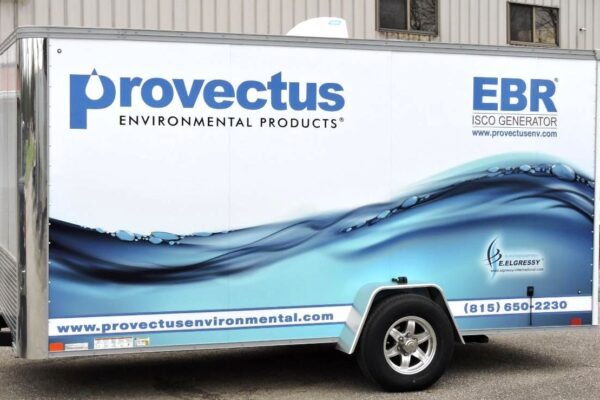Safer, More Effective ISCO using Non-Extreme Persulfate Activation that Yields Sustained, Secondary Biotreatment
When choosing a persulfate-based ISCO reagent, the industry is faced with a growing number of options – with each reagent possessing its self-proclaimed features (Table 1). As described herein, Provect-OX® offers some important benefits not inherent to other ISCO alternatives, and it may well be your safest, most effective, most cost-efficient choice.
|
Table 1. Comparative Analysis of Select Persulfate-Based ISCO Reagents.
|
▼Feature
|
Persulfate Only (unactivated)
|
Provect-OX™
|
PersulfOx®
|
Base-Activated Persulfate
|
|
Packaging
|
Provided as a granular product
|
– Provided as pre-mixed granular product with built-in activator
– Optional two-part dry system for field flexibility
|
Provided as a single-part, granular product with built-in activatora
|
Two part system: ca. 25% NaOH + granular persulfatea
|
|
Field Application
|
– Single set of hoses and pumps
– No secondary containment required
|
– Single set of hoses and pumps
– No secondary containment required
|
– Single set of hoses and pumpsa
– No secondary containment requireda
|
– Multiple injection systems requireda
– NaOH requires secondary containmenta
|
|
Safety
|
Granular, bagged material is safe and easy to handle
|
– Granular, bagged material is safe and easy to handle
– No heat generated minimizes gassing and surfacing issues
|
Granular, bagged material is safe and easy to handlea
|
– NaOH is corrosive and may cause serious injurya
– NaOH complicates material compatibilitiesa
– Heat generated during applicationa
|
|
Activation Chemistry
|
– Mainly activated by naturally occurring ferric iron, and perhaps other metals
– Natural variability and aquifer heterogeneity compromise engineering control and predictability
|
– Safely catalyzed process without the hazards of extreme activation
– Remains activated for extended periods
– Activation predictable and reliable
|
-Safely catalyzed process without the hazards of extreme activationa
– Remains activated for extended periodsa
|
– Extremely elevated pH (>10.5)a
– Activation short-liveda
– Variable performancea
– High pH can mobilize heavy metals
|
|
Modes of Action
|
Conventional persulfate oxidation chemistry
|
– Conventional persulfate oxidation chemistry
– Ferrate radicals improve oxidation results
– Sustained secondary enhanced biological processes improve overall performance
|
– Conventional persulfate oxidation chemistry
– Perhaps others
|
– Conventional persulfate oxidation chemistry
– High pH is simply not conducive to biological processes
|
|
Designed to Manage Contaminant Rebound
|
No
Multiple injection events often required
|
Yes
Actively sustains secondary treatment
|
No
Multiple injection events often required
|
No
Multiple injection events often required
|
|
“Patented” Technologies as per notes
|
No per b,c,d,e
|
Pending
(Provectus)
|
Yes
(Regenesis)
|
Yes
|
a Data for PersulfOx and “Base-Activated Persulfate” taken from Regenesis mailer received April 21, 2015.
b Henderson, J.F. 1958. The Reaction of Potassium Persulphate with Thioglycolic Acid in Aqueous Solution. McGill University, Montreal, Canada. https://provectusenvironmental.com/marketing/tech_docs/JohnHenderson_1958.pdf
c Cuypers, C., T. Grotenhuis, J. Joziasse and W. Rulkens. 2000. Rapid Persulfate Oxidation Predicts PAH Bioavailability in Soils and Sediments. Environ. Sci. Technol. 34(10) pp. 2057-2063.
d Pugh, J.R. 1999. In Situ Remediation of Soils Containing Organic Contaminants Using the Electromigration of Peroxysulfate Ions. US Patent 5,976,348. https://provectusenvironmental.com/marketing/tech_docs/USPTO_5976348_Pugh_1999.pdf
e Todd, S.M. 1964. Some Speculation on the Oxidation-Reduction Mechanisms and their Significance in the Induction of Cancer. Pages 444- 457. https://provectusenvironmental.com/marketing/tech_docs/SMTodd_1964.pdf
|
TWO IMPORTANT ISSUES ASSOCIATION WITH ISCO TECHNOLOGIES
Rebound : Perhaps the main problem with unactivated persulfate or conventional ISCO chemistries summarized above relates to the common problem of contaminant rebound. McGuire
et al. (2006) summarized this phenomenon well by comparing contaminant removal over time from numerous ISCO projects: a majority of the ISCO sites analyzed exhibited: i) initial (perhaps significant) contaminant reduction (dissolved phase) followed by ii) contaminant rebound within a few years’ time (
Figure 1). This is a response of initial oxidation reactions degrading targeted organic compounds in the dissolved phase, but once the reactive species were consumed or exhausted, nothing remained to deal with compounds that desorbed from the aquifer matrix. This led to rebound overt time, with the degree of rebound being a function of multiple factors such as oxidant loading rate, soil type and texture, hydrogeological conditions, microbiological attenuation, et cetera (Tsitonaki
et al., 2010;
Watts, 2011).
Figure 1. Temporal concentration records for wells at source depletion sites. Concentration is normalized by the initial measured concentration. Sampling time is normalized by the time of the initial source depletion treatment. (T.M. McGuireet al./ Ground Water Monitoring & Remediation 26, no. 1: 73-84 p.77)

X-axis showing sampling time (years) relative to initial treatment (Time 0)
To manage rebound, Provect-OX employs ferric iron to activate persulfate (Scalzi and Karachalios, 2013). This unique chemistry yields very effective, short-term ISCO (see below) but also enhances bioremediation processes over an extending period of time. This is accomplished via the subsequent utilization of sulfate and iron as terminal electron acceptors for facultative reductive processes. Degradation intermediates generated during oxidation of contaminants and other naturally occurring organics such as humic acids may act as electron shuttles, allowing the reduction of Fe(III) to Fe(II) in the redox cycling of iron and continued activation of persulfate. This combined remedy provides supplemental treatment mechanisms thereby allowing for more cost-efficient dosing of the product.
Alternative methods of stimulating secondary biodegradation processes using oxygen release compounds (such as calcium or magnesium oxyhydroxide) are limited in that they will remain active for only a few months, after which time their oxygen release potential is exhausted. In addition, the released oxygen will tend to migrate into the vadose zone where it may not provide any benefit in terms of groundwater treatment. Iron, on the other hand, will remain active for many years. Moreover, oxygen release compounds inherently increase the local pH to extremely basic conditions (>10 pH units) which is simply not conducive to biological activity.
Mode of Action: Provect-OX employs multiple oxidation chemistries which gives it a wide range of oxidant activity:
- Persulfate radical
- Ferrate
- Persulfate

Persulfate is activated by Fe III which requires a lower activation energy than alternative mechanisms while not consuming the oxidant. Activation is believed to be a result of the transiently elevated oxidation state of the iron to a supercharged iron ion (Fe +6 or ferrate), which itself may act as an oxidant. As this supercharged iron cation is consumed, the resulting ferric species can act as a terminal electron acceptor for biological attenuation. Coincidentally, the generated sulfate ion from the decomposition of the persulfate provides a terminal electron acceptor for sulfate reducers which may further remediate the targeted compounds in the groundwater and soils. The reactions that occur in the chemical oxidation include persulfate radicals and ferrate, as summarized below (Equation 1):
S2O8-2+ Fe+3 ———> Fe(+4 to +6) + SO42- + SO42-* (Eq. 1)
BENEFITS OF PROVECT-OX COMPARED TO OTHER PERSULFATE-BASED ISCO TECHNOLOGIES
More Effective: Promotes multiple oxidation reactions and free radicals yielding the most effective situ oxidation of a wide-range of organic contaminants. Also provides a unique microbiological component for multiple accelerated attenuation processes.
More Efficient: Significantly lower costs as a result of multiple oxidants and secondary treatment processes. Use of ferric oxide conserves oxidant when compared to EDTA-FeIII chelated iron activation.
Safer: Fewer health and safety concerns as compared to use of traditional activation methods such as heat, chelated metals, and hydrogen peroxide or pH extremes using NaOH.
- Contains built-in activation which eliminates the need for additional and potentially hazardous chemicals required to achieve traditional persulfate activation.
- Will not generate excessive heat / off-gases
Easy to Use: Single component product with integrated activator results in simplified logistics and application.
- No additional containers or multi-step mixing ratios required prior during field application
- Fewer handling logistics and equipment compatibility issues
- No secondary containment requirements
Improved Performance: Combined remedy maximizes the inherent geochemistry of a “post-oxidation” environment for biologically based attenuation to prevent “rebound”.
- The ferrous iron and the sulfide promote the formation of pyrite to combat the toxic effects of sulfide and hydrogen sulfide accumulation while also providing a means of removing targeted organic and inorganic contaminants via precipitation reactions. Moreover, pyrite possesses a high number of reactive sites that are directly proportional to both its reductive capacity and the rate of decay for the target organics
- Will not mobilize heavy metals or lead to the generation of secondary impact issues such as elevated arsenic, chromium resulting from grossly elevated pH.
Longevity: Uniquely supports long-term, sustained (>2 years), secondary bioremediation processes to manage residuals and prevent contaminant rebound. Iron will remain in place and active for many years.
LITERATURE CITED
McGuire, T.M., J.M. McDade and C.J. Newell. 2006. Performance of DNAPL Source Depletion Technologies at 59 Chlorinated-Solvent Impacted Sites. Groundwater Monitoring & Remediation 26(1): 73-84.
Pugh, J.R. 1999. In Situ Remediation of Soils Containing Organic Contaminants Using the Electromigration of Peroxysulfate Ions. US Patent 5,976,348. (Download above).
Scalzi, M. and A. Karachalios. 2013. Chemical Oxidation and Biological Attenuation Process for the Treatment of Contaminated Media. US PTO 13/891,934. May, 2013.
Todd, S.M. 1964. Some Speculation on the Oxidation-Reduction Mechanisms and their Significance in the Induction of Cancer. Pages 444- 457. (Download above)
Tsitonaki, A., B. Petri, M. Crimi, H. Mosbaek, R. Siegrist and P. Berg. 2010. In Situ Chemical Oxidation of Contaminated Soil and Groundwater using Persulfate: A Review. Critical Rev. Environ. Sci. and Technol. 40: 55-91.





